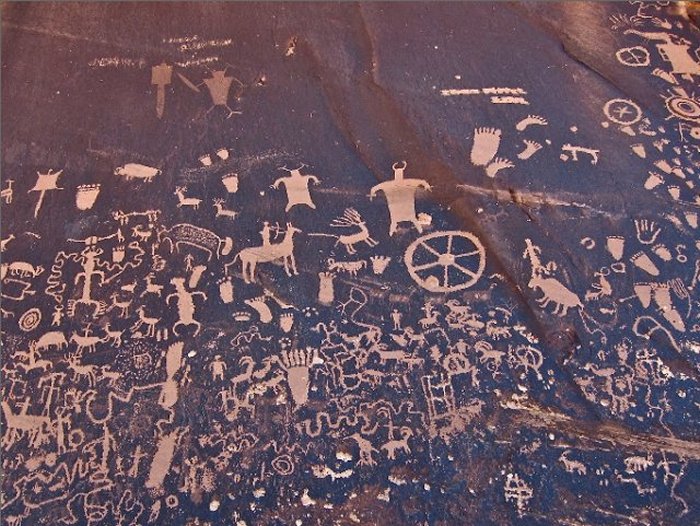Astonishing Secrets Of Legendary Kachinas: Watchers Of The Hopi
Ellen Lloyd - AncientPages.com - The Austrian J.F Blumrich - a friend of the White Bear, an old and wise member of the Hopi Tribal Council - documented some of the Hopi's beliefs.
He also had an interesting dialogue with the White Bear. During this conversation, the White Bear revealed astonishing secrets regarding the legendary Kachinas (Kyakyapchina).
The Hopi Indians are an American culture consisting of about 5000 inhabitants living in Arizona. The Hopi consider their land to be sacred.
They received the land from the "Great Spirit" and it is their duty to guard and take care of the land. Although the Hopi do not possess any written records of their ancient myths and legends, they have, thanks to oral traditions managed to preserve the knowledge of their ancient visitors.
In ancient times when the Hopi did not know the art of writing, all the knowledge of their origin was kept in the mind of the oldest and most intelligent man or woman in the tribe.
Therefore, when this person died a lot of valuable information was unfortunately lost.
Hopi, which means "peace", are usually reluctant to share their beliefs with strangers.
According to the Hopi, the Kachinas were no gods but they could be described as watchers. The gods sent them and their mission was to teach, defend, and watch over the Hopi.
The Kachinas were real physical beings of flesh and blood, and they looked just like ordinary humans. They came from a distant planet the Hopi called Tóonáotakha, located outside our solar system.
The Kachinas used flying vehicles to move around on Earth, or when they traveled back to their home planet.
These flying machines had different sizes and names. One of them was called "Páatoówa ".
This object was used to fly above the water. Furthermore, their crafts were extremely fast and the Kachinas could conquer immense distances in space in only a few seconds.
Just like other sky gods in various cultures around the world, the Kachinas were also responsible for creating the Man. The Hopi Indians tell that humans were created under mysterious circumstances.
Chosen women got pregnant without having any intercourse. This reminds us immediately of how Maria became pregnant and Jesus Christ was born.
One of the Hopi civilization's most interesting petroglyphs is called the "Star-blower". It tells a story of how the Hopi's ancestors, the Kachinas, had visited various worlds and traveled through endless space before they finally reached the Earth. This petroglyph also depicts several strange and unearthly figures, of which symbolism is difficult to understand for people outside the Hopi tribe.
There is no doubt that the Kachinas played an essential role in the daily and religious life of the Hopi. They influenced the Indians to such an extent that they even today perform traditional dances to honor their ancient Kachina visitors.
The Hopi are not the only ones, who believe in the Kachinas.
Other Indian tribes such as the Navajo and Zuni Indians share the same beliefs. The Hopi manufacture small dolls looking like the Kachinas and give them to the children so they will not be scared when the Kachinas come back one day.
The Hopi are convinced that their ancestors will return.
Although the Hopi elders are reluctant to share the details of the legend, the petroglyphs, nevertheless, show strange beings performing an extraordinary ritual.
Written by - Ellen Lloyd – AncientPages.com
Copyright © AncientPages.com All rights reserved. This material may not be published, broadcast, rewritten or redistributed in whole or part without the express written permission of AncientPages.com
More From Ancient Pages
-
 Evidence Of 7,200-Year-Old Cheese Production Found On Dalmatian Coast
Archaeology | Sep 7, 2018
Evidence Of 7,200-Year-Old Cheese Production Found On Dalmatian Coast
Archaeology | Sep 7, 2018 -
 Why Is Europe Called Europe?
Ancient History Facts | Apr 21, 2016
Why Is Europe Called Europe?
Ancient History Facts | Apr 21, 2016 -
 Mysterious Mermaid Mummy Investigated By Scientists
News | Feb 22, 2022
Mysterious Mermaid Mummy Investigated By Scientists
News | Feb 22, 2022 -
 Ancient Maya Destroyed Their Environment 2,000 Years Ago – Effects Are Still Visible Today
Civilizations | Sep 9, 2015
Ancient Maya Destroyed Their Environment 2,000 Years Ago – Effects Are Still Visible Today
Civilizations | Sep 9, 2015 -
 Groundbreaking Discovery Reveals High Cognitive Abilities In Humans Who Lived 170,000 Years Ago
Archaeology | Feb 7, 2022
Groundbreaking Discovery Reveals High Cognitive Abilities In Humans Who Lived 170,000 Years Ago
Archaeology | Feb 7, 2022 -
 Ancient Wooden Sculpture Unearthed In Peru’s Chan Chan
Archaeology | Jul 12, 2022
Ancient Wooden Sculpture Unearthed In Peru’s Chan Chan
Archaeology | Jul 12, 2022 -
 Locations Of 11 Lost Ancient Cities Revealed On 4,000-Year-Old Artifacts
Archaeology | Nov 15, 2017
Locations Of 11 Lost Ancient Cities Revealed On 4,000-Year-Old Artifacts
Archaeology | Nov 15, 2017 -
 Evidence Humans Have Been Using Bear Skins For At Least 300,000 Years Discovered
Archaeology | Dec 27, 2022
Evidence Humans Have Been Using Bear Skins For At Least 300,000 Years Discovered
Archaeology | Dec 27, 2022 -
 Riddle Of Two Undeciphered Elamite Scripts
Featured Stories | May 19, 2021
Riddle Of Two Undeciphered Elamite Scripts
Featured Stories | May 19, 2021 -
 Brihadeshwara Temple – Outstanding Example Of Chola Architecture In Tamil Nadu, India
Featured Stories | Aug 26, 2021
Brihadeshwara Temple – Outstanding Example Of Chola Architecture In Tamil Nadu, India
Featured Stories | Aug 26, 2021 -
 Three 1850-Year-Od Stone Ossuaries Prevented From Looting Near Kafr Kanna In Galilee
Archaeology | Jun 21, 2023
Three 1850-Year-Od Stone Ossuaries Prevented From Looting Near Kafr Kanna In Galilee
Archaeology | Jun 21, 2023 -
 Urban Resiliency Lie Within Ancient Cities – New Study Suggests
Archaeology | Jul 25, 2023
Urban Resiliency Lie Within Ancient Cities – New Study Suggests
Archaeology | Jul 25, 2023 -
 On This Day In History: Massacre In Great Temple Of The Aztec Capital Tenochtitlan – On May 20, 1520
News | May 20, 2016
On This Day In History: Massacre In Great Temple Of The Aztec Capital Tenochtitlan – On May 20, 1520
News | May 20, 2016 -
 Medieval Mythbusting – New Research Rewrites History Of Glastonbury Abbey
Archaeology | Nov 23, 2015
Medieval Mythbusting – New Research Rewrites History Of Glastonbury Abbey
Archaeology | Nov 23, 2015 -
 Secret Passageways And Caves Beneath Nottingham Castle
Featured Stories | Dec 6, 2015
Secret Passageways And Caves Beneath Nottingham Castle
Featured Stories | Dec 6, 2015 -
 What America’s First Board Game Can Teach Us About The Aspirations Of A Young Nation
Featured Stories | Jun 6, 2024
What America’s First Board Game Can Teach Us About The Aspirations Of A Young Nation
Featured Stories | Jun 6, 2024 -
 Roman Forum (‘Forum Romanum’) – The Heart Of Ancient Rome
Featured Stories | Aug 5, 2019
Roman Forum (‘Forum Romanum’) – The Heart Of Ancient Rome
Featured Stories | Aug 5, 2019 -
 Excavations At Okazaki Castle Reveal A 400-Year-Old Massive Unbroken Wall
Archaeology | Apr 16, 2016
Excavations At Okazaki Castle Reveal A 400-Year-Old Massive Unbroken Wall
Archaeology | Apr 16, 2016 -
 Legend Of Marguerite de Bressieux: Brave Noblewoman Who Sought Revenge For Sexual Assault
Featured Stories | Mar 29, 2020
Legend Of Marguerite de Bressieux: Brave Noblewoman Who Sought Revenge For Sexual Assault
Featured Stories | Mar 29, 2020 -
 More Than 2,500 Years Old Gallic Tombs Unearthed In Nîmes, Southern France
Archaeology | Aug 17, 2020
More Than 2,500 Years Old Gallic Tombs Unearthed In Nîmes, Southern France
Archaeology | Aug 17, 2020




